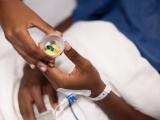A study led by researchers at the University of Oxford provides new insight into how antimicrobial resistance evolves in patients with bacterial infections.
The study, published this week in Nature Communications, found that in patients colonized with Pseudomonas aeruginosa, resistance evolved more rapidly in response to antibiotic treatment among those with multiple strains of the pathogen, compared with those with a single strain.
The study authors say the findings demonstrate the link between within-host diversity and resistance and suggest that measuring the diversity of bacterial pathogen populations might make it more possible to predict which patients will fail antibiotic treatment.
Mixed-strain populations develop resistance more rapidly
For the study, researchers analyzed P aeruginosa isolates from patients enrolled in the ASPIRE-ICU study, a multicenter European epidemiologic cohort study aimed at identifying incidence and predictors of P aeruginosa and Staphylococcus aureus infections in intensive care units (ICUs). Pseudomonas is an opportunistic pathogen that can cause severe infections in critically ill and immunocompromised hospital patients and develops resistance to antibiotics at a very high rate.
Although the within-host drivers of resistance are poorly understood, the researchers note, the predominant theory is that patients are generally infected by a single strain of a bacterial pathogen and that resistance emerges through natural selection of isolates that have developed or acquired resistance mutations during their infection.
The goal of their analysis was to test the hypothesis that antimicrobial resistance in P aeruginosa and other pathogens may evolve more rapidly when patients are infected by multiple strains because more genetic diversity accelerates the evolutionary response to antibiotic treatment.
To characterize the diversity of P aeruginosa within patients, the researchers sequenced the genomes of 441 isolates from lower respiratory tract samples of 35 ICU patients in 12 hospitals. They then measured the resistance of isolates to a panel of six antibiotics (ciprofloxacin, meropenem, gentamicin, aztreonam, ceftazidime, and piperacillin-tazobactam) and calculated the change in the proportion of isolates that were resistant to each antibiotic over time for each combination of patient and antibiotic.
This very clear result suggests that pathogen diversity is associated with the rapid emergence of resistance because diverse pathogen population are more likely to contain pre-existing resistant strains, and not because diversity per se accelerates the emergence of resistance within strains.
Nearly two-thirds of the patients (23 of 35) were colonized by a single P aeruginosa strain, but the rest were colonized by multiple strains. Analysis of the response to antibiotics showed that while resistance developed in the patients colonized with single strains in response to antibiotic treatment, the increases in resistance over time were 20% larger in patients colonized by multiple strains.
Further investigation of the mixed-strain populations in five patients revealed that isolates associated with multidrug-resistant (MDR) P aeruginosa strains repeatedly replaced isolates associated with non-MDR strains in four of those patients in response to antibiotic treatment. Furthermore, in three of the five patients colonized with multiple P aeruginosa strains, the MDR strains were detected prior to antibiotic treatment. When exposed to antibiotics, these pre-existing MDR strains had a competitive advantage over the non-MDR strains.
Based on these findings, the study authors estimate that more than 90% of the increase in antimicrobial resistance in patients with mixed-strain populations is driven by selection for pre-existing resistant strains.
"This very clear result suggests that pathogen diversity is associated with the rapid emergence of resistance because diverse pathogen population are more likely to contain pre-existing resistant strains, and not because diversity per se accelerates the emergence of resistance within strains," they wrote.
There were fitness trade-offs associated with mixed-strain populations, however. When the researchers measured the growth rate of isolates from all patients in an antibiotic-free medium, MDR isolates grew more slowly, and that trade-off was stronger in mixed-strain populations.
Infection prevention, better diagnostics
The lead study author says the findings highlight the importance of infection prevention and control measures that lower the risk of colonization with opportunistic pathogens like P aeruginosa. He also suggests that better diagnostic methods are needed to identify patients with multi-strain infections and assess their antimicrobial resistance potential.
"The diagnostic methods that we use to study antibiotic resistance in patient samples have changed very slowly over time, and our findings underscore the importance of developing new diagnostic methods that will make it easier to assess the diversity of pathogen populations in patient samples," Craig Maclean, PhD, a professor of evolution and microbiology at Oxford, said in a university press release.






















